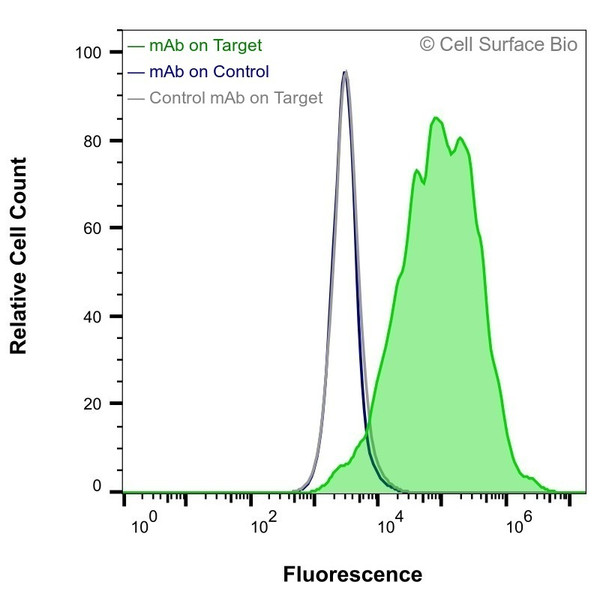- Description
| Specificity Profile | More Information |

|
The specificity of APOE Monoclonal Antibody (CSB0031) was tested on the Membrane Proteome Array® and shown to be specific for human APOE. The Membrane Proteome Array® contains 6,000 different human membrane proteins, each expressed in unfixed human cells to ensure native conformation and post-translational modifications. The Membrane Proteome Array® represents the industry standard for determining the binding specificity of antibodies and other protein ligands. |
| Application | Conditions | Recommended Concentration |
| Flow Cytometry, Extracellular | Live, Unpermeabilized | 1 µg/ml |

|
HEK-293F cells transiently transfected with human APOE were stained with APOE Monoclonal Antibody (CSB0031) (green) or isotype control antibody (gray), followed by AlexaFluor 647- conjugated anti-Mouse IgG secondary antibody. HEK-293F cells transiently transfected with an empty control vector were also stained with APOE Monoclonal Antibody (CSB0031) (blue). | |
| Application | Conditions | Recommended Concentration |
| Immunofluorescence, Extracellular | Fixed 4% paraformaldehyde | 1 µg/ml |

|
(Left) COS-7 cells transiently transfected human APOE were stained with APOE Monoclonal Antibody (CSB0031) followed by AlexaFluor 647 anti-Mouse IgG secondary antibody (red) and DAPI (blue). (Top right) COS-7 cells transiently transfected with an empty control vector stained with APOE Monoclonal Antibody. (Bottom right) Isotype control: COS-7 cells transfected with human APOE and stained with control MAb. | |
| Application | Conditions | Recommended Concentration |
| Immunofluorescence, Intracellular | Fixed 4% paraformaldehyde, Permeabilized 0.1% Triton X-100 | 1 µg/ml |

|
(Left) COS-7 cells transiently transfected human APOE were permeabilized and stained with APOE Monoclonal Antibody (CSB0031) followed by AlexaFluor 647 anti-Mouse IgG secondary antibody (red) and DAPI (blue). (Top right) COS-7 cells transiently transfected with an empty control vector stained with APOE Monoclonal Antibody. (Bottom right) Isotype control: COS-7 cells transfected with human APOE and stained with control MAb. | |
CSB VeRSaMAbs:
We produce and validate all our monoclonal antibodies
in-house so that you can confidently choose the right antibody for your assay. All antibodies are
VALIDATED for common applications, RECOMBINANT for batch-to-batch consistency, and
SPECIFIC in binding to only your target.
| Target | APOE |
| Target Aliases | AD2, LDLCQ5, APO-E, ApoE4, Apo-E, LPG, Apolipoprotein E, Apolipoprotein E3 |
| Isotype | Mouse IgG2a |
| Membrane Proteome Specificity | Monospecific for 6,000 membrane proteins tested |
| Species Reactivity | Human (Others untested) |
| Fc Modifications | C-terminal Avitag, disabled Fc-gamma receptor binding |
| Source | Recombinant CHO expression; purified by Protein A chromatography |
| Formulation | Endotoxin Free PBS pH 7.4, sterile-filtered |
| Concentration | 1 mg/ml |
Stable for 12 months from date of receipt when stored at 4°C. Avoid repeated freeze-thaw cycles.
APOE is an apolipoprotein, a protein that associates with lipid particles. APOE is a component of plasma lipoproteins and is involved in lipoprotein-mediated lipid transport between organs via plasma and interstitial fluids. APOE is secreted and binds multiple types of lipoproteins and cellular receptors and is required for the normal catabolism of triglyceride-rich lipoprotein constituents. Mutations in APOE cause familial dysbetalipoproteinemia (type III hyperlipoproteinemia). (NCBI Gene: 348, UniProtKB/Swiss-Prot: P02649) Other names: AD2, LDLCQ5, APO-E, ApoE4, Apo-E, LPG, Apolipoprotein E, Apolipoprotein E3





